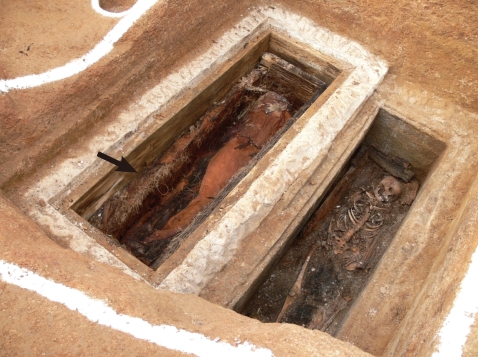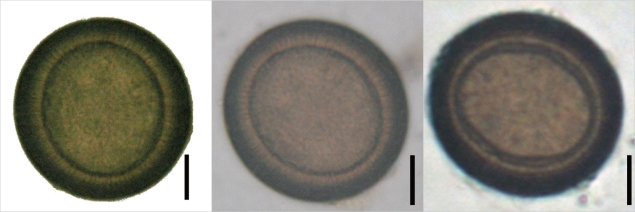The rapid development of paleoparasitology in Korea has occurred in recent years, especially with discovery of mummies from the Joseon Dynasty [1,2]. When the soil sediments from Korean medieval tombs were examined for the presence of parasite eggs, we also recovered numerous eggs [3]. The ancient eggs were mostly recovered from the samples of tombs encapsulated with lime-soil mixture barrier (LSMB), which were commonly constructed for ruling class from the 15th to 19th centuries [4]. The recovered eggs mainly belonged to Trichuris trichiura and Ascaris lumbricoides, while Clonorchis sinensis, Paragonimus westermani, and Metagonimus yokogawai were occasionally found [3]. Even the larvae of Strongyloides stercoralis and the eggs of Gymnophalloides seoi were discovered in our studies [2,5].
Human taeniasis is known to be distributed worldwide, and the beef tapeworm, Taenia saginata, has been regarded as dominant over Taenia solium [6]. However, we could not discover any Taenia spp. eggs in archeological samples from Korea. Based on paleoparasitological reports from the world, the first discovery of ancient Taenia spp. eggs was from a 3,200-year-old Egyptian mummy [7]. Subsequently, taeniid eggs were reported from various archeological sites around the world. Briefly, the eggs were discovered in a mummy from a Christian Necropolis in Egypt, the embalming reject jars of Egypt, and a Han-Dynasty mummy in China [8-10]. Even the characteristic feature of cysticercosis was also reported in an Egyptian mummy from the Ptolemaic period [11]. Based on these findings, it was very unusual that taeniid eggs have not been found from archeological remains in Korea despite that Korea is known to be an endemic area for taeniasis. Even though the locality and date was not described, the prevalence of Taenia tapeworms among Koreans was quoted as 16% or 7-8% in the 1920s according to a report by Inoba in 1924, as reviewed by Eom and Rim [12]. In addition, nationwide parasitological surveys showed that the egg-positive rates for taeniasis fluctuated between 0.02% and 1.9%, even in the late 20th century [12,13].
While molecular paleoparasitological diagnosis by using PCR is sensitive enough to diagnose the parasite in a sample with only 30 parasite eggs, microscopic analysis often fails to detect small numbers of parasite eggs [14]. Hence, voluminous examination of archeological samples is needed for detection of low-density eggs when molecular diagnosis is unavailable. To confirm the negativity of Taenia spp. eggs in our archeologically-obtained collection, we re-examined the samples maintained in our collection, especially those in perfect preservation status. The sample collected from the tomb in Gongju-si was one such example, worthy of re-examination. In the tomb of Gongju-si, 2 coffins were found encapsulated with lime-soil mixture barrier (LSMB), possibly those of a husband and a wife (Fig. 1). As the husband was buried on the right side to his wife during the Joseon Dynasty, the left coffin was supposed to be that of the husband. The sample for the present study was collected from the husband's coffin, that consisted of the soil sediment spread upon the hip bones of a man living in the late 17th century. In our previous examinations, eggs of Ascaris lumbricoides, Trichuris trichiura, and Paragonimus westermani along with the larvae of Strongyloides stercoralis were detected from the left coffin [5]. This abundance of helminth ova or larvae in this sample raised hope that we might discover Taenia sp. eggs from this sample too, considering prevalence of Taenia parasitism among the Korean population. The rehydration method used in this study generally followed the method previously reported [5]. While a 400-µl of rehydrated sample was examined before, 18 ml of rehydrated sample was examined in the present study, which was nearly 45 times more than the previous examinations.
In the present study, the eggs found at first examination, i.e., A. lumbricoides, T. trichiura, and P. westermani, were also recovered (data not shown). In addition, taeniid eggs were recovered from the samples. They revealed characteristic features of taeniid eggs with a radially striated embryophore, although hooklets were not clearly observed (Fig. 2). A total of 5 Taenia spp. eggs were recovered from the sample. Since 2 of them were unmeasurable due to a partial destruction, 3 of them were photographed and measured (Fig. 2). They were 37.5-40.0 µm×37.5 µm in size, and 5.6 µm in thickness of the embryophore.
This is the first discovery of taeniid eggs from archeological samples of Korea. Since species differentiation was not possible by microscopic examinations, the precise species should be evaluated further in forthcoming studies, especially by molecular studies. Considering that taeniid eggs were not found in the first examination and that only 5 Taenia eggs were discovered from all of the remaining samples at this time, intensive examination on voluminous samples will be needed for identification of Taenia eggs in archeological samples from Korea.
Among the various helminth eggs, those of Taenia spp. have not frequently been discovered in archeological samples [10]. The scarcity of taeniid eggs could be explained as follows: First, the ancient taeniid eggs were usually preserved in mummies, but not in soil sediments at archeological sites [10]. In addition, among various geological strata in archeological sites of Belgium, the eggs of Taenia spp. were discovered only in those of recent days [15]. This suggested that the egg shells of Taenia spp. are fragile and not suitable for long-term preservations [9]. Second, the infection rate of Taenia spp. might be lower than that of other helminth species. In Korea, the positive rate of Taenia spp. was only 1.9% in 1971 when the overall parasite positive rate was 84.3% [16]. Third, Taenia spp. eggs escape from the uterus through the ruptured wall after the gravid proglottid becomes free from the strobila [17]. This might result in scarcity of taeniid eggs in the coprolites or soil samples.
In order to find out more Taenia spp. eggs in archeological samples from Korea, we should consider that T. solium and T. asiatica, especially the latter, were prevalent in Jeju-do with its complete life cycle. The report on Jeju inhabitants showed that 27.2% of them had an experience of eating raw pig liver, more than those of any other province [12]. In fact, the taeniid infection rate of Jeju-do was 1.5% in 1992, while in other geographic areas the infection rate was ≤0.3% [16]. Furthermore, 6% of the populations on Cheju Island (Jeju-do) were suspected to carry 2 adults of T. asiatica on average in 1986 and 1987 [18], and a survey of neurocysticercosis prevalence among epilepsy patients showed that the island had the highest positive rate (8.4%) among all areas of Korea [19]. Therefore, our next paleoparasitological study must include works on samples from Jeju-do where the ancient taeniid eggs might have a greater likelihood of discovery.








